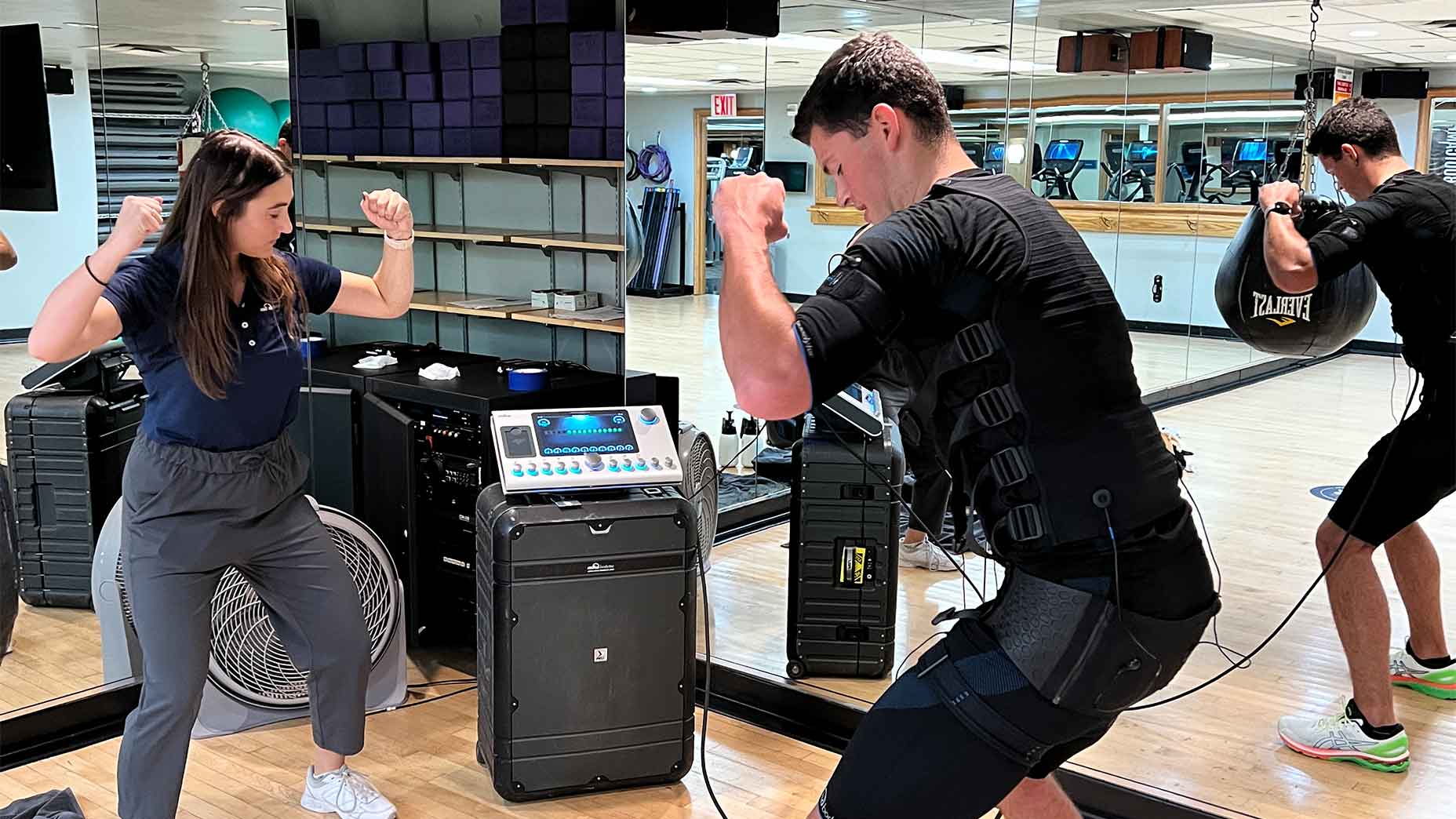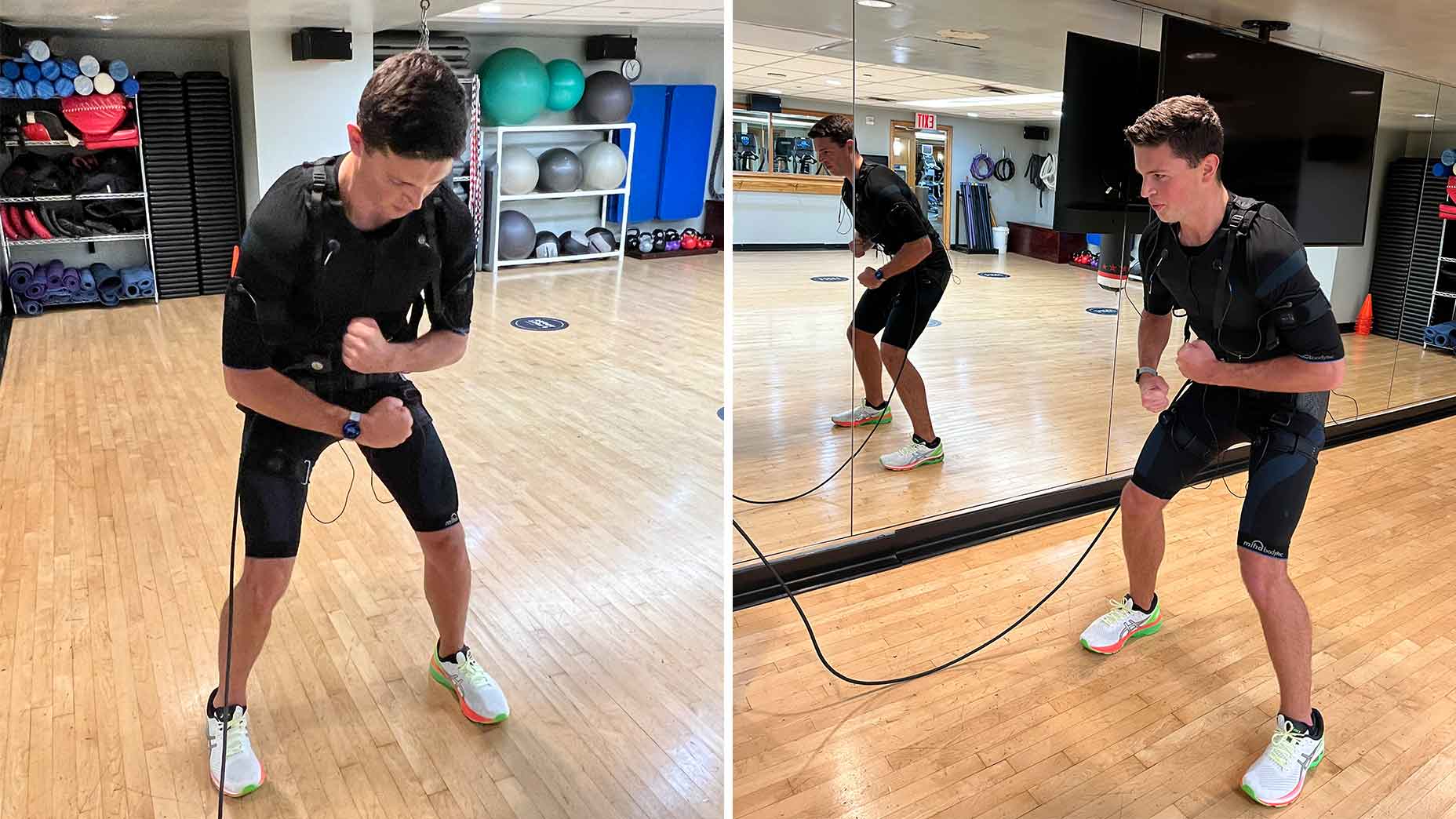This space-age workout has golfers’ swing speeds skyrocketing

Trust me ... it feels even stranger than it looks.
Brian Dillman
Some rules of the universe were meant to be broken. Some, it turns out, were not.
In my outrageously fortunate 24 years, I have found only three unbreakable rules. As of this writing, they are as follows:
- Treat service workers with respect
- Do not recline your seat in coach
And, most pressingly, 3. Whatever you do, wherever you are, in whichever circles you decide to travel, never, ever let a friend sign you up for an exercise class.
Sure, you can break these rules, but not without consequence. Perhaps you’ll miss a flight. Perhaps you’ll come down with a particularly nasty bout of food poisoning.
Or perhaps you’ll be like me and endure something far, far worse.
The friend’s name was Sean Zak. That might sound familiar if you’re a regular reader of this website — Sean is one of GOLF’s senior editors.
Sean is a good guy. More than that, he’s a normal guy. He’s been through the ringer at GOLF — the recipient of an embarrassing workout with an English LPGA Tour pro, a sweaty and ultimately unsuccessful swing lesson from a major champion, and internet shame after a short-armed throw to Patrick Mahomes.
When he reached out to take stock of my interest in breaking my third and most rigid rule, I made the first mistake of workout classes. I listened.
“It sounds cool, it’s in New York City,” he’d goaded, winding up for the knockout blow.
“And it’s free.”
I relented.
“Alright, sign me up!”
A week later, I found myself entering the AXA Equity building in midtown Manhattan. It’s a posh, well-traveled space, with the three-starred Michelin restaurant Le Bernardin on the ground floor.
There is a quiet, swanky gym in the basement, which is typically reserved for employees of the building. It was here, in the New York Swim and Athletic Club, that I found myself embroiled in the strangest workout of my adult life. One that involved an electric current, a dizzying array of wires and cords, and a set of skin-tight spandex. A workout that left me mildly embarrassed, completely exhausted and legitimately sore … in 12 minutes. Using equipment that, to the best of my knowledge, may have been plucked unambiguously from the set of Terminator.
This is my experience with the exercise class of our Jetson’s-shaped, speed-swinging future: Miha bodytec.
When I met Brian Dillman in the lobby shortly before my class was scheduled to begin, he flashed a quick smile.
“Do you know what you’re getting into here?” He asked.
Uh oh.
“Not exactly,” I replied.
“Good,” he said. “It’s better that way.”
I followed him into the training studio, where he introduced me my instructor, Jacki Berardi — a sprightly former college golfer at the University of Dayton. Before we could do much speaking, Dillman pulled a series of black garments from his bag.
“What size do we think?” He said, looking at me. “Large?”
He scooped the clothing, revealing a set of skin-tight spandex tights broken into shorts and a short-sleeve t-shirt.
“Go to the locker room and take off everything underneath. Then come back up here,” he said.
“Everything?”
“Yeah, everything.”
I scrambled down to the locker room and, after a moment or three of sheer embarrassment, stripped down into my new clothes. As I walked back toward the studio, I caught a glimpse of myself in the mirror.
I snapped a photo and sent it Sean.
“This is the LAST time I say yes to something you send me.”
When I returned upstairs, I found Dillman holding what looked unmistakably like a suicide bomb. Wires and straps protruded every which way from the black vest, which was oddly dripping wet.
“Slip this on,” Dillman instructed, handing me a series of additional straps for my legs, arms and waist.
Once the straps were tightened, Dillman yanked a series of wires out from his bag and began connecting them at various points on my arms, shoulders, torso and legs. When he was finished, he grabbed what looked to be a power cord — three or four times the size of the other wires — and strapped it directly to the center of my chest. The cord ran back to a metallic box sporting a series of dials and a blue screen.
Now, dear reader, feels like a good time to remind you I hadn’t the slightest clue what in the hell was going on. By the time I finally did begin to receive an explanation on the terms of the workout, I’d already convinced myself that I had wronged Sean in some grave way and, as punishment, he’d hired Brian and Jacki as contract killers. That they would electrocute me, or worse, torture me, until my brain was charred to a delightful crisp.
By the time I realized I wasn’t, in fact, about to earn an introduction with Jimmy Hoffa, Berardi had already turned on the machine.
“It’s electric muscular stimulation,” she said. “What it’s doing is mimicking the signals your brain sends to your muscles when you’re lifting or working out. So, it’s getting muscles to contract the same way your brain makes it happen, but more efficiently. With this, you’re getting 85 muscle contractions per second instead of one for every repetition.”
The vest, Berardi explained, was creating an electromagnetic current that stimulated every muscle in my chest, back and torso. The spandex, while embarrassing, served a critical role in promoting the current. The vest was drenched with water for the same reason.
“You’re going to feel it tingle a little bit,” she said. “But it won’t hurt, and it’s not supposed to be uncomfortable. From a one to a 10, we want you to be at a four.”

Slowly, she began to turn the knobs on for each muscle group, starting with my legs and slowly progressing up my body to my back, shoulders, chest and arms. The feeling was a bit like an ultrasound — a whole-body vibration that wasn’t painful, but oddly wearing.
“Normally, we have people do a 20-minute strength training session,” she said. “But since this is your first time, we’re going to have you go for 12 minutes.”
I shrugged. I’d explained to Dillman and Berardi my regular workout habits, which included four to five days of strength training, and two-to-three of cardio. Most days, I work out for upwards of an hour. Twelve minutes? I could handle it.
Berardi instructed me that the machine worked in four-second increments. For every movement, I would have four seconds to complete the movement, then four seconds to rest.
We started with squats, which were easy enough … for the first three reps. My heart rate soared, prompting a workout notification from my smartwatch. After what felt like a long time, we transitioned to lunges. Then came ab work – standing crunches and thoracic rotations. Dillman, who was providing resistance, encouraged me to throw him into the wall. The more I engaged the muscles, Berardi explained, the more I would get from the workout.
I was pleased when, on the next rotation, I managed to break Dillman’s balance slightly. Perhaps sensing my precociousness, he informed me a UFC fighter had once *literally* thrown him into the wall.
I chatted throughout the beginning of the workout, but by the end of the rotational work, there was silence. I was drenched in sweat and completely out of breath, my heart rate comfortably in the 160s.
“You’re doing great,” Berardi encouraged. “Only eight minutes left.”
Eight minutes. That could only mea — yes. In four (4) minutes (with no weights), Miha had pushed me to the brink.
Then came upper-body work. Easier, but still exhausting.
Finally, the eight minutes passed. I slumped over, gasping, sweat dribbling down the bridge of my nose and onto the studio’s linoleum floor. Berardi and Dillman chuckled.
“Congrats,” Berardi chimed. “You just did two-and-a-half hours of high-intensity training.”
“Holy s—,” I replied breathlessly.

For the CEO of a lifestyle product, Brian Dillman is refreshingly blunt.
He doesn’t speak in flowery cliches or uninterpretable buzzwords. He shoots from the hip, even when it’s about his own product.
Like me, he’d heard of Miha — originally developed and popularized in Germany — from a friend. And like me, he was a little skeptical.
“I said, ‘this is total bulls—. This is eight-minute abs. I’m not doing this,’” Dillman remembers lustily. “And then I did my first workout.”
Dillman was so struck by his experience with Miha, he signed on to head up the U.S. business before it received full clearance from the Food and Drug Administration. The green light from the FDA came a short while later (which is no small feat, as those of us who have paid attention to public health over the last two years know).
Soon, Dillman’s focus shifted to public relations — convincing a nation of athletes to willingly sign up for the strangest workout class they’d ever seen.
He started by reaching out to coaches, including a handful of TPI-certified golf teaching professionals, and eventually recruited a small base of players to try the workout. Rave reviews followed, particularly in golf, where players saw two-pronged success in one of the sport’s biggest buzzwords: swing speed.
Some players, the instructors found, were unlocking immediate ball speed boosts with Miha upwards of 10 mph, while others found it easier and quicker to reach their max speed, in theory lessening the load of training and warm-ups.
“We looked at each other and said, ‘I think we found something here,’” Dillman said.
In golf, Miha feels it’s found a target audience. At the highest levels, EMS training is a rocket booster for speed and performance. Among amateurs, it’s a low-impact, low commitment way for players to prevent injury, stay in shape, and train during the offseason.
And players are responding in kind. With Miha, strength sessions are streamlined and fitness goals easier to attain, leaving more time for players to spend out on the range or in pursuit of more speed. This, of course, comes in addition to Miha’s many other functional benefits, including increased flexibility and mobility, improved core and back strength, and boosted circulation.
Thanks to the strain it places on the body (and diminishing returns over longer workout periods), Miha only recommends doing one 20-minute session per week. That’s quite alright with most clients, who have no complaints about squeezing a week’s worth of strength training into their lunch break (one 20-minute session burns more than 1,100 calories, on average).
“Eighty percent of the U.S. population isn’t going to the gym,” Dillman says of Miha’s appeal. “For golfers, this is a solution to stay in shape, first and foremost. But it’s a way to stay in shape and hopefully help your golf game in the process.”
After my session was over, Jacki Berardi, my instructor, warned me to stay away from strength training for a few days.
“You need to give your body time to recover,” she said, explaining that my CK levels — a measure of muscle waste — would spike over the coming days to similar levels seen in marathon runners.
Rest would be no issue. I rose the morning after my workout feeling battered. My muscles were swollen, bringing a dull ache with every movement, and my back was on fire.
Miha had done a brilliant job of activating those hard-to-train postural muscles in the lower and mid-back. After years of soft tissue injuries from golf, the soreness was oddly intoxicating — as if Miha had reminded me of the blind spots in my current training regimen.
It didn’t take my body long to feel as if it had recovered fully from my session. And, while it’s certainly anecdotal evidence, I noticed I looked more toned and maintained better posture in the week following Miha than the one leading into it.
Before I left the studio, I stopped Berardi, the former college golfer.
I wondered, what was Dillman’s pitch to her?
“You can improve your game and improve your body, it’s only once a week, and you don’t have to go the gym,” she said. “What’s better than that?”
Which brings me to my fourth rule of the universe: Try everything once. Even the weird stuff.
Especially the weird stuff.










